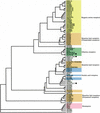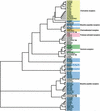G protein-coupled receptor genes in the FANTOM2 database
- PMID: 12819145
- PMCID: PMC403690
- DOI: 10.1101/gr.1087603
G protein-coupled receptor genes in the FANTOM2 database
Abstract
G protein-coupled receptors (GPCRs) comprise the largest family of receptor proteins in mammals and play important roles in many physiological and pathological processes. Gene expression of GPCRs is temporally and spatially regulated, and many splicing variants are also described. In many instances, different expression profiles of GPCR gene are accountable for the changes of its biological function. Therefore, it is intriguing to assess the complexity of the transcriptome of GPCRs in various mammalian organs. In this study, we took advantage of the FANTOM2 (Functional Annotation Meeting of Mouse cDNA 2) project, which aimed to collect full-length cDNAs inclusively from mouse tissues, and found 410 candidate GPCR cDNAs. Clustering of these clones into transcriptional units (TUs) reduced this number to 213. Out of these, 165 genes were represented within the known 308 GPCRs in the Mouse Genome Informatics (MGI) resource. The remaining 48 genes were new to mouse, and 14 of them had no clear mammalian ortholog. To dissect the detailed characteristics of each transcript, tissue distribution pattern and alternative splicing were also ascertained. We found many splicing variants of GPCRs that may have a relevance to disease occurrence. In addition, the difficulty in cloning tissue-specific and infrequently transcribed GPCRs is discussed further.
Figures






References
-
- Akhundova, A., Getmanova, E., Gorbulev, V., Carnazzi, E., Eggena, P., and Fahrenholz, F. 1996. Cloning and functional characterization of the amphibian mesotocin receptor, a member of the oxytocin/vasopressin receptor superfamily. Eur. J. Biochem. 237: 759-767. - PubMed
-
- Alcedo, J., Ayzenzon, M., Von Ohlen, T., Noll, M., and Hooper, J.E. 1996. The Drosophila smoothened gene encodes a seven-pass membrane protein, a putative receptor for the hedgehog signal. Cell 86: 221-232. - PubMed
-
- Bartfai, T., Hokfelt, T., and Langel, U. 1993. Galanin—A neuroendocrine peptide. Crit. Rev. Neurobiol. 7: 229-274. - PubMed
WEB SITE REFERENCES
-
- ftp://ftp.ncbi.nih.gov/genbank/genomes/M_musculus/CHR_Y/; mouse Y-chromosome.
-
- ftp://wolfram.wi.mit.edu/pub/mouse_contigs/MGSC_V3; the MGSCv3 assembly.
-
- http://genome.cse.ucsc.edu/goldenPath/22Dec2001; human Y-chromosome sequences, GoldenPath.
-
- http://genomes.rockefeller.edu/MouSDB; M. Zavolan comprehensive database of probable splice variants.
-
- http://www.informatics.jax.org; MGI: Mouse Genome Informatics resource.
Publication types
MeSH terms
Substances
Grants and funding
LinkOut - more resources
Full Text Sources
Molecular Biology Databases
